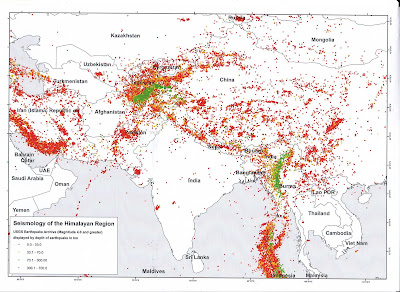Definitely a lot of takeaway and most thankful to them for sharing their rich resources.
Using Maps for inquiry based learning:
Each group was allocated one of the three types of plate boundary locations and tasked to describe the patterns of the
1. Topography and bathymetry (where is the high and low terrain? Are there linear or random features? Are features parallel or not? And so on...)
2. Volcanoes (randomly distributed or not? If not, in a line or zone? Wide or narrow? Continuous or intermittent? Refer to the topography/bathymetry, And so on...)
3. Earthquakes (Randomly distributed or not? If not, in a line or zone?Wide or narrow? All the same focus depth or not? If not, is there a pattern to the depths or not? If there is a pattern, describe. Refer to the topography/bathymetry, And so on...)
4. Seafloor age (Younger/older in which directions? Are age bands wide or narrow compared with other areas? Refer to the topography/bathymetry, And so on...)
Then form a hypothesis on:
Where is the plate boundary? What kind of plate boundary is this? How do you know? Support your hypothesis with evidence.
Plate boundary location: Between South American Plate and African Plate
Plate boundary location: Between Australian Plate and Eurasian Plate
She showed us how the data on the depth of earthquake can be used to show the subduction of the oceanic plate below the continental plate.
Learned a new term today - visco-elastic. Is the mantle solid? No. Is the mantle liquid? No. It is visco-elastic! Dawn and Jamie used oobleck to illustrate (Jamie made this out of cornstarch) If you pound on it quickly it is like a solid. However if you place your finger on it or put pressure on it slowly, you can pierce through it like a liquid.
Using vegetable oil and syrup we experimented on how viscosity affects the amount of gases trapped - she also mentioned that we can use honey to show higher viscosity.
We also experimented on how greater amount of gases could be more explosive by using coca cola - one which was already opened containing less gas and the other a new one with more gases.
I also like how Jamie demonstrated how new rocks are formed at the oceanic ridge using two papers.
I also like the following:
Using a
The modelling clay is also fantastic in demonstrating the difference types of stress (force/unit area):
squeezing (compression), pulling (tension) and smearing (shearing)
When stress is applied quickly versus slowly, different strain occur:
- elastic strain- temporary and original shape is maintained
- plastic strain - permanent - ductile deformation in which original shape is not maintained and if the stress is greater than the strength of the material, it will bend or fold.
- brittle - permanent - brittle deformation in which the original shape is not maintained and if stress is greater than the strength of material it will break or fracture.
Brittle deformation occurs commonly at the surface of the earth (lower temperature). Faults form in the shallower parts of the crust.
Ductile deformation occurs at depth (higher temperatures) Folds form in deeper part of the crust.
Thus faults occur as well as folding at the Himalayas.
Also learned that the materials in the mantle not only because of the increased temperature but also can be due to the decrease in pressure and water. Jamie demonstrated by using a vacuum pump to pump out air from a bottle containing hot water. When there is less air, the hot water actually boiled with bubbles appearing.


Also love some of the videos she showed:













